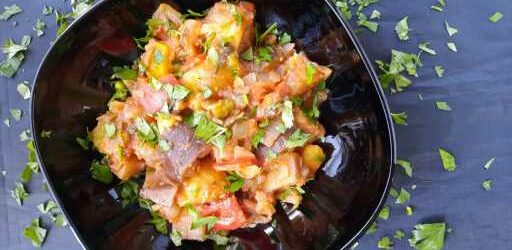We say Fahrenheit, miles and cilantro. Nearly everyone else on the globe says Celsius, kilometers and coriander.
Coriandrum sativum, its Linnaean name, is a plant that gives both the green herb that we call cilantro and the slightly brown seed, often ground into a powder, that we call coriander (or coriander seed). It is one of the oldest of herbs and seasonings, dating back 7,000 years in the Mediterranean basin, its presumed birthplace. (A small packet of seeds was found neatly tucked into Tutankhamun’s tomb.)
Northern Europeans tend to favor the seeds in cooking (and in fermenting, both breads and alcoholic beverages such as gin). The leaves appear in many Latin American and Southeast Asian dishes. Unlike most other European peoples, the Portuguese use fistfuls of it, especially in their soups, a legacy of their colonization of much of southern Africa.
The coriander plant is closely related to both celery and parsley and its green leaves often confused with the flat-leaf version of the latter, although they are wildly different. You might even see “cilantro” labeled as “Chinese parsley” in some Asian groceries, but again, it is parsley in name only.
Some people are averse (that is too mild a word) to cilantro. Julia Child once told Larry King, during one of his shows, that she would pick it out of any dish “and throw it on the floor.” Science explains that genetic factors, unevenly distributed among the Earth’s people, probably explain why cilantro smells and tastes like soap to those who identify as cilantro-averse.
For example, women in general are more likely to detect the “soap” in cilantro; African Americans, the Latinx community and East and South Asians seem to have less trouble with cilantro than Northern Europeans.
The recipe here is a terrific one and comes from the Caucasus country of Georgia. Layers of flavor impress here and come by way of the cook adding the same ingredients at different stages. So, for instance, fresh garlic gets introduced midway but also toward the end, for two different “flavors” of garlic.
Similarly, coarsely chopped cilantro leaves appear in two acts. And we even have coriander powder, from the dried seeds of the spotlighted culinary plant here.
I found a couple of pronunciations of this preparation online. A little practice and you’ll be rattling off “a-ZHAP-sahn-DOLL-ee” like a Georgian herself.
One very nice facet of ajapsandali is making more than you’d need for one sitting because the leftovers are better than the first showing. Plus, ajapsandali tastes delicious warm, with a swirl of extra virgin olive oil atop it, or (as I found to my delight) with a chill on it, as leftovers of course, topped with more cilantro.
Unless you are averse to that idea. (In which case, you might substitute celery leaves or dill fronds for the cilantro.)
Ajapsandali (Georgian “Ratatouille”)
Adapted from Benjamin Kemper at saveur.com and Bill St. John. Serves 4-6.
Ingredients
- 2 medium Yukon Gold potatoes, unpeeled
- 1⁄3 cup mild-tasting extra-virgin olive oil, plus more as needed (ghee OK)
- 2 pounds eggplant, stemmed, unpeeled and cut into 3⁄4-inch chunks (see note)
- 2 teaspoons sea or kosher salt, divided, plus more to taste
- 2 large yellow onions, peeled and coarsely chopped
- 2 large Cubanelle peppers, seeded and cut into 3⁄4-inch pieces (see note)
- 1 medium red or yellow bell pepper, seeded and cut into 3⁄4-inch pieces
- 2 cups uncooked tomato purée (passata), fresh or jarred
- 1⁄3 cup coarsely chopped cilantro, divided
- 1⁄3 cup coarsely chopped flat-leaf parsley leaves, divided
- 20 basil leaves, preferably purple (Thai or “holy”), torn
- 1⁄4–1⁄2 teaspoon cayenne pepper, to taste
- 1⁄2 teaspoon coriander powder
- 1⁄4 teaspoon savory or dried thyme leaves, crushed in hand
- 3 garlic cloves, mashed into a paste, divided
- Water or vegetable broth
Directions
Microwave the potatoes on High, turning them halfway through cooking, until fork tender, 9–11 minutes, depending on size. When cool enough to handle, cut into 3⁄4-inch chunks and set aside.
Meanwhile, to a large pot set over medium-high heat, add the oil (or ghee). When hot and shimmering, add the eggplant and 1 teaspoon of the salt. Turn the heat to medium and cover. Cook, stirring occasionally, until the eggplant begins to color and break down, about 20 minutes. Using a slotted spoon or “spider,” transfer to a paper-towel-lined plate and set aside.
Turn the heat to high. To the empty pot, add the onion and remaining salt and cook, stirring frequently and adding more oil or ghee if needed, until translucent and brown in spots, about 10 minutes. Add the Cubanelle and bell peppers and cook, stirring occasionally, until softened slightly, about 3 minutes. Stir in the tomato purée and only half each of the cilantro, parsley and basil.
Add 1/2 of the garlic paste, all of the cayenne, coriander, thyme, reserved potatoes and eggplant and 1 cup of water or vegetable broth and bring to a boil. Turn the heat to medium, cover and cook, stirring occasionally, until thickened slightly, anywhere from 10-20 minutes. To your choosing.
Stir in the remaining 1/2 garlic and remaining cilantro, parsley and basil and cook until fragrant, about 1 minute. Season with salt and serve hot, at room temperature or even chilled, drizzled with oil if desired.
Cook’s notes: About the eggplant, use whatever suits your (or the market’s) fancy: large purple glove, elongated violet Asian, small ball-like Thai, and so forth. About the spicy peppers, substitutions abound for Cubanelle: Anaheim, “sweet” Italian, sweet red Bulgarian.
Subscribe to our weekly newsletter, In The Know, to get entertainment news sent straight to your inbox.
Source: Read Full Article



